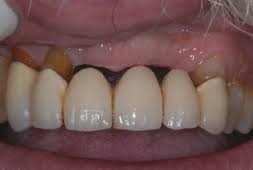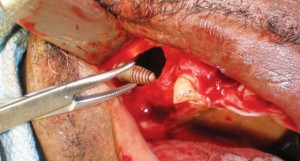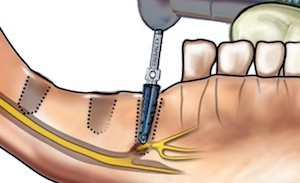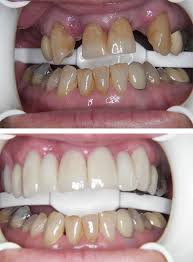Advantages of Dental Implants – as opposed to Bridges
Implants does not affect the adjacent teeth
One of the greatest advantages of bridges is that you do not need other teeth to support it. They can therefore be placed without damaging other healthy teeth. It may also be – that the adjacent teeth already support a bridge or had other expensive dental treatment done which you would not like to remove/ disturb. Implants can also be utilized in cases where there are no suitable teeth adjacent to the space to retain a bridge. If the adjacent teeth get decayed, infected or fractured, it will not affect the implant. On the other hand, if it happens to a tooth supporting a bridge, the patient could lose the bridge.

Implant doesn’t affect adjacent teeth.
Implants do not decay
I found that a lot of patients get decay of the teeth supporting the bridge. It is usually the root or area near or even under the gumline that gets decayed. The decay is therefore often difficult to diagnose and treat. The result is those patients often end up needing a new bridge, root canal treatment or even worse – loose another tooth. Because implants are made from metal they cannot get tooth decay.
Easy to keep clean and less likely to develop gum disease
It can be a bit tricky to floss thoroughly under a bridge and patients can develop gum disease around the supporting teeth. This will affect the bone which supports the teeth and in severe cases, the teeth may become mobile. The benefit of an implant is that the tooth is not connected to other teeth and it is therefore easy to floss and keep it clean around the implant. Although it is possible to get gum disease around an implant it is less likely, especially if the patient maintains good oral hygiene.
Aesthetic
Both implants and bridges can provide an aesthetic and pleasing result. Unfortunately you will get bone loss in an area where a tooth has been extracted and the bony ridge will start to get smaller. As a bridge doesn’t address this problem at all, it may be that the contour of the ridge and gums next to the pontic (false tooth of a bridge) doesn’t look nice and natural after a few years, and you may even start to see an increasing larger gap between the gum and the bridge. With an implant, the bone grows around the implant as if it is a natural tooth root, and you can therefore maintain the natural looking contour of the bone and gums around the implant.

Bone loss above a dental bridge.
Advantages of Dental Bridges – as opposed to Implants
No Surgery Required
This is probably the most important advantage of dental bridges. No surgery is required!
Risks of implant surgery:
- Infection at the site of the implant.
- You can suffer damage to the surrounding blood vessels, nerves or teeth.
- Sinus problems can occur if an implant penetrates the sinus during placement. In order to prevent this, there may be cases where a sinus lift operation will be required before implant placement. In some cases an upper implant may not be possible due to the position of the sinus.

Implants displaced into the maxillary sinus
- Risk of nerve damage leaving the patient with a numb lip.

Risk of nerve damage
- It may be that the bone doesn’t fuse to the titanium implant, in which case the implant may need removal and the procedure redone.
- Due to the risks involved with surgery, some patients may not be approved for implants due to medical factors e.g.: Patients who are bleeders or using Warfarin, patients who received radiotherapy in the head/neck area, people with a severe immune deficiency, uncontrolled diabetes etc.
- The surgery and subsequent healing takes more time than when you get a bridge done.
- Pain due to surgery.
- Bone grafts may be required before the implant can be placed.

Bone grafting or sinus lift may be required
Bridges are more affordable.
As no surgery, bone grafts/ sinus lifts are required; bridges are generally not as expensive as implants. Patients usually need to see more than one dental specialists if the need an implant (one who will do the surgery and another who will place the crown), this will certainly also increase the cost of implants. Many dental insurance plans/medical aids do not want to pay for implants or crowns supported by implants.
Final result can be achieved within a short period of time.
Usually it only requires two appointment (a week or two apart) to prepare and place a bridge. On the other hand implants can often only be placed after the initial extraction site has healed. More planning time will be required for implants and often extra consultations with the surgeon who will place the implant. The patient may also require a bone graft which requires healing time. After implant placement it also usually takes a few months before the final restoration (crown) is placed. There are some cases where implants are placed directly after tooth extraction but every case will not be suitable for immediate implant placement.
Adjacent teeth can be treated at the same time.
If the teeth adjacent to the gap are decayed, heavily restored, discolored or do have an odd shape, size or position – these can all be treated or improved be placing a bridge. The patient may therefore end up with a more esthetic result with a bridge rather than an implant.

Bridges improve the appearance of adjacent teeth as well.
Some patients are not suitable candidates for Dental implants
Patients who smoke, suffer from diabetes or other serious medical conditions may not be approved for implant surgery. It is also not a good idea to place implants in young children as they jaw still need to grow and develop. Elderly patients with weakened immune systems may also be discouraged from getting implants placed. As mentioned before, there may not be enough bone to support and implant, the sinus may be in the way for an upper implant or a nerve in the lower jaw. In some of these cases, dental bridges may be a suitable alternative.
Personal preference
Both dental implants and bridges are reliable, predictable, functional and aesthetic pleasing. As both options have its pros and cons, it often comes down to the patient’s own personal preference as to go for and implant or a bridge. It is important for patients to make sure they understand all the benefits and risks involved before making a decision.
It is also extremely important to maintain excellent oral hygiene, regardless of whether you choose a bridge or an implant .